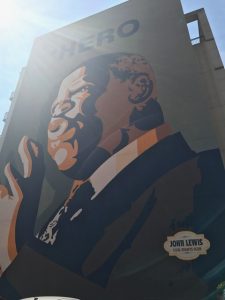
This image is of a very popular mural painted on the side of a building and faces the interstate.
In front of this mural is a small parking lot thats reserved for what seemed to be government cars. The mural had a small emblem on the bottom that denoted it as a government sanctioned and protected piece of wall art. I share a special connection with the mural, as does any true Atlantian, because I’ve passed by this mural countless times while on the I-75 overpass. It serves as a reminder of Atlanta’s rich history and past and our progressive future. However, it provides an interesting perspective to the connotations of having such a mural on broad display to anyone passing by the city or entering from the airport. It is a welcome sign that reminds the viewer of our pride in black history. Also, graffiti is a common thing on the walls that line the city but this is a new take. This mural is a new, fresh, expensive, take on graffiti. Instead of being an unappealing mark on the area, the John Lewis mural serves as a clean look and a proud display.
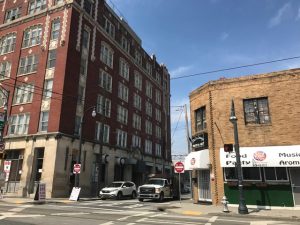
This image is of a street corner off of Auburn Avenue show the contrast of the different uses of the historical street and district.
The image of this street corner is a scene seen on many blocks on Auburn Avenue. While almost all of Sweet Auburn is historic, not all of the buildings that stand today are treated as historical nor do all of them maintain the façade of such a responsibility. Much of the space has been repurposed to cater to the current consumerist population. In some cases that presents itself as a shop that is a very apparent indicator of gentrification, like Arden’s Gardens and the Expresso Bar, and in other cases it is a small food mart such as this. Whichever the case, it was very interesting to see them wedged into the spaces left in between historical buildings.
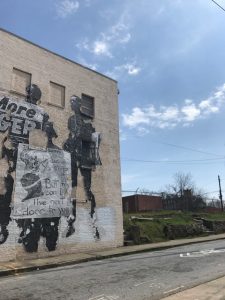
This image is of printed graffiti on the side of a seemingly abandoned building, beside which is an empty plot of land.
These images on the side of the building are more akin to what sort of political graffiti I’m used to seeing in other parts of Atlanta. The building on which this mural was abandoned, with the window shattered in and inside there were a peculiar set of things like refrigerators, dance studio-esque glass walls, and white picket fence wood. On the back side of the building, around the corner to the main sidewalk of Auburn Avenue, there is a plot of land that is also abandoned. As can be seen on the side of the picture, the area looks a lot like the site of ruins. I would expect a plot of land and ruins like this in ancient excavation sites, definitely not in the midst of an urban landscape that is going through renewal and gentrification. While that plot of land is probably of high value, it would be nice to see the people who own the plot to rebuild the historic building or do something to compliment the Sweet Auburn aesthetic rather than allow the place to be turned into a gentrification project that attracts a different population. While this would likely bring in more revenue to the area, seeing the poor job the municipal government has done to preserve the historic value of this community, I doubt that the money would go into helping those negatively impacted by gentrification and would rather be fed into the cycle of urban renewal of a space that should be protected.
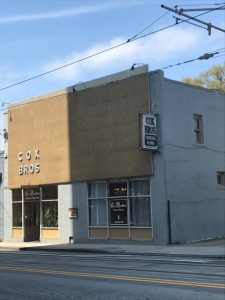
This image is of a funeral home found on Auburn Avenue, which seemed peculiarly placed.
I snapped this picture because I found the contrast quite peculiarly and a bit odd, if not humorous. This funeral home is directly across the street from the Wheat Street Towers, which are the only senior living complex located directly on historic Sweet Auburn Avenue. Although conveniently located for their target consumers, it seems almost rude to have the storefront as a constant reminder of mortality. In the same little strip mall, there is a second funeral home company, a cigar shop, and a place to purchase hair. The combination of these shops and their proximity to the retirement home make it quite the humorous sight on a stroll down Auburn Avenue. As discussed on the tour, this retirement home and the strip malls surrounding it have real potential for urban renewal and making the area one that would be desirable to live in. This potential is apparent in the modern chic decor of the outside of the funeral home’s storefront, which is not similar to the other storefronts in the area.
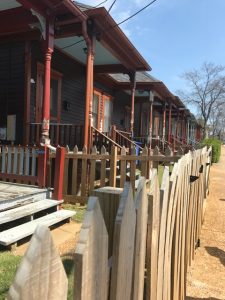
This image shows the shotgun homes that are located on the same street as the childhood home of Dr. Martin Luther King, Jr.
This is my favorite picture taken on our trip to Auburn Avenue. These shotgun houses showed the condition and economic dynamic in the absence of words. There are little plaques planted about that mark these little homes as historic sites although they are private residences still. While today they might seem nice to live, in a quirky small cottage-life kind of way, there’s a stark contrast between these homes and the ones across the street. Both sides of the street accommodate homes that have relatively fresh paint, most commonly of the pastel color kind, and have porches well known to old southern ways. However, these shotgun houses have about a hair’s width between each other and their porches are practically the only open air space they have. Across the street there are larger houses, usually of multiple stories, with large porches followed by decently sized front yards. One of these homes was the King family’s. The high maintenance and care of this sector of Auburn Avenue is a testament to the frequent visitors who pay homage to Dr. Martin Luther King’s home. A few blocks going towards downtown, Auburn Avenue has a different feel, one of half hearted preservation of historic sites and forgotten ethnic history in the midst of gentrification.